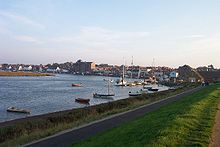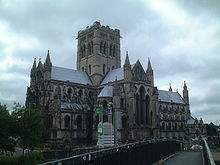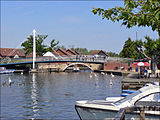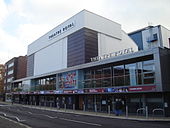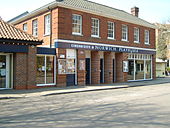- Norfolk
-
This article is about the county in England. For the city in the United States, see Norfolk, Virginia. For other uses of the term "Norfolk", see Norfolk (disambiguation).
Norfolk 
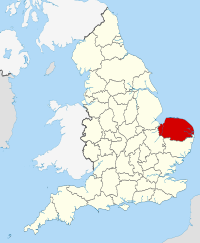
Geography Status Ceremonial and Non-metropolitan county Region East of England[1] Area
- Total
- Admin. councilRanked 5th
5,371 km2 (2,074 sq mi)
Ranked 5thAdmin HQ Norwich ISO 3166-2 GB-NFK ONS code 33 NUTS 3 UKH13 Demography Population
- Total (2010 est.)
- Density
- Admin. councilRanked 25th
862,400
161 /km2 (420 /sq mi)
Ranked 7thEthnicity 98.5% white Politics 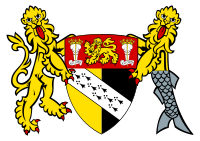
Arms of Norfolk County Council with supporters
Norfolk County Council
http://www.norfolk.gov.uk/Executive Conservative Members of Parliament - Richard Bacon (C)
- Henry Bellingham (C)
- Elizabeth Truss (C)
- Chloe Smith (C)
- Norman Lamb (LD)
- Brandon Lewis (C)
- George Freeman (C)
- Simon Wright (LD)
Districts 
Norfolk (
 /ˈnɔrfək/) is a low-lying county in the East of England. It has borders with Lincolnshire to the west, Cambridgeshire to the west and southwest and Suffolk to the south. Its northern and eastern boundaries are the North Sea coast and to the north-west the county is bordered by The Wash. The county town is Norwich. Norfolk is the fifth largest ceremonial county in England, with an area of 5,371 km² (2,074 sq mi).
/ˈnɔrfək/) is a low-lying county in the East of England. It has borders with Lincolnshire to the west, Cambridgeshire to the west and southwest and Suffolk to the south. Its northern and eastern boundaries are the North Sea coast and to the north-west the county is bordered by The Wash. The county town is Norwich. Norfolk is the fifth largest ceremonial county in England, with an area of 5,371 km² (2,074 sq mi).Of the 34 non-metropolitan English counties, Norfolk is the seventh most populous, with a population of 850,800 (mid 2008). However, as a largely rural county it has a low population density, 155 people per square kilometre (or 401 per square mile). Norfolk has about one-thirtieth the population density of Central London, the tenth lowest density county in the country, with 38% of the county’s population living in the three major built up areas of Norwich (259,100), Great Yarmouth (71,700) and King's Lynn (43,100).[2] The Broads, a well known network of rivers and lakes, is located towards the county's east coast, bordering Suffolk. The area has the status of a National Park and is protected by the Broads Authority.[3] Historical sites, such as those in the centre of Norwich, also contribute to tourism.
Contents
History
Norfolk was settled in pre-Roman times, with camps along the higher land in the west where flints could be quarried.[4] A Brythonic tribe, the Iceni, inhabited the county from the first century BC, to the end of the first century (AD). The Iceni revolted against the Roman invasion in 47 AD, and again in 60 AD led by Boudica. The crushing of the second rebellion opened the county to the Romans. During the Roman era in Norfolk roads and ports were constructed throughout the county and farming took place.
Situated on the east coast, Norfolk was vulnerable to invasions from Scandinavia and northern Europe, and forts were built to defend against the Angles and Saxons. By the 5th century the Angles, after whom East Anglia and England itself are named, had established control of the region and later became the "north folk" and the "south folk", hence, "Norfolk" and "Suffolk". Norfolk, and several adjacent areas, became the kingdom of East Anglia, later merging with Mercia and then Wessex. The influence of the Early English settlers can be seen in the many place names ending in "-thorpe", and "-ham", as well as "-ton" or "-don" for Celtic place names, In the 9th century the region again came under attack, this time from Vikings who killed the king, Edmund the Martyr. Again, local place names, such as those ending "-by" or "-thwaite", bear testimony to Viking settlement. In the centuries before the Norman Conquest the wetlands of the east of the county began to be converted to farmland, and settlements grew in these areas. Migration into East Anglia must have been high, as by the time of the Conquest and Domesday Book survey, it was one of the most densely populated parts of the British Isles. During the high and late Middle Ages the county developed arable agriculture and woollen industries. Norfolk's prosperity at that time is evident from the county's large number of mediaeval churches: of an original total of over one thousand, 659 survive, more than in the whole of the rest of Great Britain.[5] The economy was in decline by the time of the Black Death, which dramatically reduced the population in 1349; suffice to say that the current population has yet to equal the population before that time. Over one-third of the population of Norwich died during a plague epidemic in 1579.[6] By the 16th century Norwich had grown to become the second largest city in England, but in 1665 the Great Plague again killed around one third of the population.[7] During the English Civil War Norfolk was largely Parliamentarian. The economy and agriculture of the region declined somewhat, and during the industrial revolution Norfolk developed little industry except in Norwich and was a late addition to the railway network.
In the 20th century the county developed a role in aviation. The first development in airfields came with the First World War; there was then a massive expansion during the Second World War with the growth of the Royal Air Force and the influx of the American USAAF 8th Air Force which operated from many Norfolk Airfields. During the Second World War agriculture rapidly intensified, and has remained very intensive since, with the establishment of large fields for cereal and oil seed rape growing. Norfolk's low-lying land and easily eroded cliffs, many of which are chalk and clay, make it vulnerable to the sea, the most recent major event being the North Sea flood of 1953.
The low-lying section of coast between Kelling and Lowestoft Ness in Suffolk is currently managed by the Environment Agency to protect the Broads from sea flooding. Management policy for the North Norfolk coastline is described in the North Norfolk Shoreline Management Plan which was published in 2006 but has yet to be accepted by the local authorities.[8] The Shoreline Management Plan states that the stretch of coast will be protected for at least another 50 years, but that in the face of sea level rise and post-glacial lowering of land levels in the South East, there is an urgent need for further research to inform future management decisions, including the possibility that the sea defences may have to be realigned to a more sustainable position. Natural England have contributed some research into the impacts on the environment of various realignment options. The draft report of their research was leaked to the press, who created great anxiety by reporting that Natural England plan to abandon a large section of the Norfolk Broads, villages and farmland to the sea to save the rest of the Norfolk coastline from the impact of climate change.[9]
Economy and industry
In 1998 Norfolk had a Gross Domestic Product of £9,319 million, making it 1.5% of England's economy and 1.25% of the United Kingdom's economy. The GDP per head was £11,825, compared to £13,635 for East Anglia, £12,845 for England and £12,438 for the United Kingdom. In 1999–2000 the county had an unemployment rate of 5.6%, compared to 5.8% for England and 6.0% for the UK.[10]
Much of Norfolk's fairly flat and fertile land has been drained for use as arable land. The principal arable crops are sugar beet, wheat, barley (for brewing) and oil seed rape. Over 20% of employment in the county is in the agricultural and food industries.[11]
Well-known companies in Norfolk are Aviva (formerly Norwich Union), Colman's (part of Unilever) and Bernard Matthews Farms. The Construction Industry Training Board is based on the former airfield of RAF Bircham Newton. The BBC East region is centred on Norwich, although it covers an area as far west as Milton Keynes.
To help local industry in Norwich, Norfolk, the local council offered a wireless internet service but this has now been withdrawn following the end of the funding period.[12]
Education
Primary and secondary education
Norfolk has a completely comprehensive state education system, with secondary school age from 11 to 16 or in some schools with sixth forms, 18 years old. In many of the rural areas, there is no nearby sixth form and so Sixth form colleges are found in larger towns. There are twelve independent, or private schools, including Gresham's School in Holt in the north of the county, Thetford Grammar School in Thetford--Britain's fourth oldest school, Langley School in Loddon, the original Norwich boys school, Norwich School and Norwich High School for Girls in the city of Norwich itself. The Kings Lynn district has the largest school population. Norfolk is also home to Wymondham College, the UK's largest remaining state boarding school.
Tertiary education
The University of East Anglia is located on the outskirts of Norwich and Norwich University College of the Arts (previously Norwich School of Art and Design) is based in seven buildings in and around St George's Street in the city centre, next to the River Wensum.
The City College Norwich and the College of West Anglia are colleges covering Norwich and Kings Lynn as well as Norfolk as a whole. Easton College, 7 miles (11 km) west of Norwich, provides agriculture-based courses for the county, parts of Suffolk and nationally.
University Campus Suffolk also run higher education courses in Norfolk, from multiple locations including Great Yarmouth College.[13]
Politics
Norfolk is a shire county, under the control of Norfolk County Council. This is divided into seven local government districts, Breckland District, Broadland District, Great Yarmouth Borough, King's Lynn and West Norfolk Borough, North Norfolk District, Norwich City and South Norfolk.
In October 2006, the Department for Communities and Local Government produced a Local Government White Paper inviting councils to submit proposals for unitary restructuring. Norwich submitted its proposal in January 2007, which was rejected in December 2007, as it did not meet all the rigorous criteria for acceptance. In February 2008, the Boundary Committee for England, (from 1 April 2010 incorporated in the Local Government Boundary Commission for England), was then asked to consider alternative proposals for the whole or part of Norfolk, including whether Norwich should become a unitary authority, separate from Norfolk County Council. In December 2009, the Boundary Committee recommended a single unitary authority covering all of Norfolk, including Norwich.[14][15][16][17]
However, on 10 February 2010, it was announced that, contrary to the December 2009 recommendation of the Boundary Committee, Norwich would be given separate unitary status.[18] The proposed change was strongly resisted, principally by Norfolk County Council and the Conservative opposition in Parliament.[19] Reacting to the announcement, Norfolk County Council issued a statement that it would seek leave to challenge the decision in the courts.[20] A letter was leaked to the local media, in which the Permanent Secretary for the Department for Communities and Local Government noted that the decision did not meet all the criteria and that the risk of it "being successfully challenged in judicial review proceedings is very high".[21] The Shadow Local Government and Planning Minister, Bob Neill, stated that should the Conservative Party win the 2010 general election, they would reverse the decision.[22]
Following the 2010 general election, Eric Pickles was appointed Secretary of State for Communities and Local Government on 12 May 2010 in a Conservative–Liberal Democrat coalition government. According to press reports, he instructed his department to take urgent steps to reverse the decision and maintain the status quo in line with the Conservative Party manifesto.[23][24] However, the unitary plans were supported by the Liberal Democrat group on the city council, and by Simon Wright, LibDem MP for Norwich South, who intended to lobby the party leadership to allow the changes to go ahead.[25]
The Local Government Act 2010 to reverse the unitary decision for Norwich (and Exeter and Suffolk) received Royal Assent on 16 December 2010. The disputed award of unitary status had meanwhile been referred to the High Court, and on 21 June 2010 the court (Mr. Justice Ouseley, judge) ruled it unlawful, and revoked it. The city has therefore failed to attain permanent unitary status, and the previous 2-tier arrangement of County and District Councils (with Norwich City Council counted among the latter) remains the status quo.[26]
Norfolk County Council is Conservative-controlled and led by Derrick Murphy. There are 60 Conservative councillors, 13 Liberal Democrat councillors, 7 Green Party councillors, 3 Labour councillors and 1 UKIP councillor.[27] There was a 63% turnout at the most recent local election.
Following the May 2010 General Election, Norfolk will be represented in the House of Commons,by seven Conservative Members of Parliament and two Liberal Democrats. The Labour Party have lost the urban areas of Norwich and Great Yarmouth in recent elections, leaving them with no Commons representative in East Anglia; the former Home Secretary Charles Clarke being a high level casualty.
Norfolk Election Results Parliamentary 6 May 2010 County Council 4 June 2009 Party Votes Votes % Seats Seats % Party Votes Votes % Seats Seats % Conservative 188,944 43.1% 7 77.8% Conservative 115,396 45.9% 60 71.4% Liberal Democrat 121,710 27.8% 2 22.2% Liberal Democrat 56,998 22.7% 13 15.5% Labour 83,088 19.0% 0 0% Green 18,786 10.8% 7 8.3% UKIP 20,182 4.6% 0 0% Labour 33,873 13.5% 3 3.6% Others [1] 24,302 5.5% 0 0% Others [2] 17,764 7.1% 1 1.2% Totals 438,226 9 251,351 84 Turnout 66.8% 38.6% [1] Green, LCA, Independents, Others
[2] UKIP, LCA, Independents, OthersSettlements
Norfolk's county town and only city is Norwich, one of the largest settlements in England during the Norman era. Norwich is home to the University of East Anglia, and is the county's main business and culture centre. Other principal towns include the port-town of King's Lynn and the seaside resort and Broads gateway town of Great Yarmouth. There are also several market towns: Aylsham, Downham Market, Dereham, Fakenham, Diss, Holt, North Walsham, Swaffham, Thetford and Wymondham.
Transport
Further information: Railways in NorfolkNorfolk is one of the few counties in England that does not have a motorway. The A11 connects Norfolk to Cambridge and London via the M11. From the west there only two routes from Norfolk that have a direct link with the A1, the A47 which runs into the East Midlands and to Birmingham via Peterborough and the A17 which runs into the East Midlands via Lincolnshire. These two routes meet at King's Lynn which is also the starting place for the A10 which provides West Norfolk with a direct link to London via Ely, Cambridge and Hertford . The Great Eastern Main Line is a major railway from London Liverpool Street Station to Essex, Suffolk and Norfolk. Norwich International Airport, offers flights within Europe including a link to Amsterdam which offers onward flights throughout the world.
Dialect, accent and nickname
The Norfolk dialect is also known as "Broad Norfolk", although over the modern age much of the vocabulary and many of the phrases have died out due to a number of factors, such as radio, TV and people from other parts of the country coming to Norfolk. As a result, the speech of Norfolk is more of an accent than a dialect, though one part retained from the Norfolk dialect is the distinctive grammar of the region.[citation needed]
People from Norfolk are sometimes known as Norfolk Dumplings,[28] an allusion to the flour dumplings that were traditionally a significant part of the local diet.[29]
More cutting, perhaps, was the pejorative medical slang term "Normal for Norfolk",[30] alluding to the county's perceived status as an illiterate incestuous backwater. The term has never been official, and is now discredited, its use discouraged by the profession.[citation needed]
Tourism
Norfolk is a popular tourist destination and has several major examples of holiday attractions. There are many seaside resorts, including some of the finest British beaches, such as those at Great Yarmouth, Waxham, Cromer and Holkham bay. Norfolk is probably best known for the Broads and other areas of outstanding natural beauty and many areas of the coast are wild bird sanctuaries and reserves with some areas designated as National Parks such as the Norfolk Coast AONB. Tourists and locals enjoy the wide variety of monuments and historical buildings in both Norfolk and the city of Norwich.
-
The historic city of Norwich -
The Norfolk Coast at Cromer
The Queen's residence at Sandringham House in Sandringham, Norfolk provides an all year round tourist attraction whilst the coast and some rural areas are popular locations for people from the conurbations to purchase weekend holiday homes. Arthur Conan Doyle first conceived the idea for The Hound Of The Baskervilles whilst holidaying in Cromer with Bertram Fletcher Robinson after hearing local folklore tales regarding the mysterious hound known as Black Shuck.[31][32]
Amusement parks and zoos
Norfolk has several amusement parks and zoos.
Thrigby Hall near Great Yarmouth was built in 1736 by Joshua Smith Esquire and features a zoo which houses a large Tiger enclosure, primate enclosures and the swamp house which has many Crocodiles and Alligators.
Pettitts Animal Adventure Park at Reedham is a park with a mix of Animals, rides and live entertainment shows.
Great Yarmouth Pleasure Beach is a free-entry theme park, hosting over 20 large rides as well as a crazy golf course, water attractions, children's rides and "white knuckle" rides.
BeWILDerwood is an award winning adventure park situated in the Norfolk Broads and is the setting for the book A Boggle at BeWILDerwood by local children's author Tom Blofeld.
Britannia Pier on the coast of Great Yarmouth has rides which include a ghost train. Also on the Pier is the famous Britannia Pier Theatre.
Banham Zoo is set amongst 35 acres (140,000 m2) of parkland and gardens with innovative enclosures providing sanctuary for almost 1000 animals including big cats, birds of prey, siamangs and shire horses. It's annual visitor attendance is in excess of 200,000 people, and has often been awarded the prize of Norfolk's Top Attraction, by numerous different organisations, including "Best Large Attraction" by Tourism In Norfolk in 2010.
Amazona Zoo is situated on 10 acres (40,000 m2) of derelict woodland and abandoned brick kilns on the outskirts of Cromer and is home to a range of tropical South American animals including jaguars, otters, monkeys and flamingos.
Amazonia is a tropical jungle environment in Great Yarmouth housing over 70 different species of reptiles including lizards, crocodiles, snakes, tortoises and terrapins.
Extreeme Adventure is a high ropes course built in some of the tallest trees in eastern England. in the 'New Wood' part of Weasenham Woods, Norfolk.
The Sea Life Centre in Great Yarmouth is One of the biggest sea life centres in the country. The Great Yarmouth centre is home to a tropical shark display, one resident of which is Britain's biggest shark 'Nobby' the Nurse Shark. The same display, with its walk-through underwater tunnel, also features the wreckage of a World War II aircraft. The centre also includes over 50 native species including shrimps, starfish, sharks, stingrays and Conger eels.
The Sea Life Sanctuary in Hunstanton is Norfolk's leading marine rescue centre and works both as a visitor attraction as well as a location for rescuing and rehabilitating sick and injured sea creatures found in the nearby Wash and North Sea. The attractions main features are similar to that of the Sea Life Centre in Great Yarmouth, albeit on a slightly smaller scale.
Theatres
The Pavilion Theatre(Cromer) is a 510-seater venue perched on the end of Cromer pier, best known for hosting the famous' end-of-the-pier' show, the Seaside Special. The theatre also presents a high-quality mix of comedy, music, dance, opera, musicals and community shows.
Britannia Pier Theatre (Great Yarmouth) host mainly popular comedy acts such as the Chuckle Brothers and Jim Davidson. the theatre seats 1200 seats and is one of the largest in Norfolk.
Theatre Royal (Norwich) has been on its present site for nearly 250 years, the Act of Parliament in the tenth year of the reign of George II having been rescinded in 1761. The 1300-seat theatre, the largest in the city, hosts a mix of national touring productions including musicals, dance, drama, family shows, stand-up comedians, opera and pop.
Norwich Playhouse (Norwich) is a superb venue in the heart of the city and one of the most modern performance spaces of its size in East Anglia. The theatre has a seating capacity of 300.
The Maddermarket Theatre (Norwich) opened in 1921 and was the first permanent recreation of an Elizabethan Theatre. The founder was Nugent Monck who had worked with William Poel. The Theatre is a world class Shakespearean style play house and has a seating capacity of 310.
Norwich Puppet Theatre (Norwich) was founded in 1979 by Ray and Joan DaSilva as a permanent base for their touring company and was first opened as a public venue in 1980, following the conversion of the medieval church of St. James in the heart of Norwich. Under subsequent artistic directors – Barry Smith and Luis Z. Boy – the theatre established its current pattern of operation. It is a nationally unique venue dedicated to puppetry, and currently houses a 185 seat raked auditorium, 50 seat Octagon Studio, workshops, an exhibition gallery, shop and licensed bar. It is the only theatre in the Eastern region with a year-round programme of family-centred entertainment.
The Garage studio theatre (Norwich) can seat up to 110 people in a range of different layouts. It can also be used for standing events and can accommodate up to 180 people. The high specification of equipment and design means that it is particularly versatile, and can be adapted to a variety of layouts offering a wide choice for performances or events.
The CCN Drama Centre (Norwich) is in the grounds of City College Norwich (CCN), and has a massive stage. The theatre mainly plays host to Broadway style American musicals and has, in the past, presented shows such as Bugsy Malone and Copacabana and in May 2010 saw the highly successful, Thirst Productions Guys and Dolls. The theatre is raked and seats about 220 people.
The Sewell Barn Theatre (Norwich) is the smallest theatre in Norwich and has a seating capacity of just 100. The auditorium features raked seating on three sides of an open acting space. This unusual staging helps to draw the audience deeply into the performance.
The Norwich Arts Centre (Norwich) theatre opened in 1977 in St. Benedict's Street, and has a capacity of 290.
The Princess Theatre (Hunstanton) stands overlooking the Wash and green in the busy East Coast resort of Hunstanton. The Princess Theatre is a 472 seat venue dubbed as one of the friendliest theatres in the country by artists who have performed there. Open all year round, the theatre plays host to a wide variety of shows from comedy to drama, celebrity shows to music for all tastes and children's productions. The venue also has a six week summer season plus an annual Christmas pantomime.
Sheringham Little Theatre (Sheringham) provides intimate and comfortable seating for 180. The theatre programmes a wide variety of plays, musicals, music and also shows films.
The Gorleston Pavilion (Gorleston) is an original Edwardian building with a seating capacity of 300, situated on the Norfolk coast. The theatre stages plays, pantomimes, musicals, concerts as well as the popular 26 week Summer Season.
Notable people from Norfolk
Further information: Category:People from Norfolk- Peter Bellamy, folk singer and musician, who was brought up in North Norfolk
- Henry Blofeld, Cricket commentator
- Henry Blogg, the UK's most decorated lifeboatman, who was from Cromer
- Francis Blomefield, Anglican rector, early topographical historian of Norfolk
- James Blunt, English acoustic folk rock singer-songwriter who was raised in Norfolk during his childhood
- James Blyth, author of weird fiction and crime mysteries, many of which are set in and around the Norfolk Broads
- Boudica, scourge of the occupying Roman Army in first century Britain and queen of the Iceni, British tribe occupying an area slightly larger than modern Norfolk
- Sir Thomas Browne, English Renaissance writer, physician and early archaeologist
- Martin Brundle, former motor-racing driver and now a commentator was born in King's Lynn
- Edward Bulwer-Lytton, 1st Baron Lytton, writer, born at Heydon
- Dave Bussey, former BBC Radio 2 and current BBC Radio Lincolnshire presenter
- Howard Carter, archaeologist who discovered Tutankhamun's tomb; his childhood was spent primarily in Swaffham
- Edith Cavell, a nurse executed by the Germans for aiding the escape of prisoners in World War I
- Nick Conrad, UK speech radio presenter, born in Norwich
- Cathy Dennis, singer and songwriter, from Norwich
- Diana, Princess of Wales, first wife of Charles, Prince of Wales, was born and grew up near Sandringham
- Anthony Duckworth-Chad, landowner and Deputy Lord Lieutenant of Norfolk
- Sir James Dyson, inventor and entrepreneur, was born at Cromer, grew up at Holt and was educated at Gresham's School
- Bill (1916–1986), Brian (1922–2009), Eric (1914–1993), Geoff (1918–2004), John (1937–), and Justin (1961–) Edrich, cricketers
- Nathan Fake, electronic dance music producer/DJ
- Pablo Fanque, equestrian and popular Victorian circus proprietor, whose 1843 poster advertisement inspired The Beatles song, Being for the Benefit of Mr. Kite!, born in Norwich
- Natasha and Ralph Firman, racing drivers, were both born and brought up in Norfolk and educated at Gresham's School
- Caroline Flack, television presenter, who was born in Norfolk
- Margaret Fountaine, butterfly collector, was born in Norfolk, and her collection is housed in Norwich Castle Museum
- Elizabeth Fry, prominent 19th century Quaker prison reformer pictured on the Bank of England £5 note, born and raised in Norwich
- Stephen Fry, actor, comedian, writer, producer, director and author who was born in London and was brought up in the village of Booton near Reepham and also briefly attended Gresham's School. He now has a second home near King's Lynn.
- Samuel Fuller, signed the Mayflower Compact
- Claire Goose, actress who starred in Casualty, was raised in Norfolk
- Roderick Gordon, writer of Tunneles series.
- Ed Graham, drummer of Lowestoft band The Darkness, was born in Great Yarmouth
- Sienna Guillory, actress, from north Norfolk, who was educated at Gresham's School
- Sir Henry Rider Haggard, novelist, author of She, King Solomon's Mines, born Bradenham 1856 and lived after his marriage at Ditchingham
- Jake Humphrey, BBC presenter, spent most of his childhood in Norwich
- Andy Hunt, footballer, grew up in Ashill.
- Julian of Norwich, mediaeval mystic, born probably in Norwich in 1342; lived much of her life as a recluse in Norwich
- Robert Kett,leader of Kett's Rebellion in East Anglia 1549, from Wymondham
- Sid Kipper, Norfolk humourist, author, songwriter and singer
- Myleene Klass, former Hear'Say singer, comes from Gorleston
- Holly Lerski, singer and songwriter, former member of the band Angelou, grew up and resides in Norfolk
- Samuel Lincoln, ancestor of U.S. President Abraham Lincoln
- Matthew Macfadyen, actor who starred in Spooks, was born in Great Yarmouth
- Ruth Madoc, actress, was born in Norwich
- Kenneth McKee, surgeon who pioneered hip replacement surgery techniques, lived in Tacolneston
- Roger Taylor, drummer of the rock band Queen was born in King's Lynn and spent the early part of his childhood in Norfolk.
- Danny Mills, footballer, born in Norwich.
- Horatio, Lord Nelson, Admiral and British hero who played a major role in the Battle of Trafalgar, born and schooled in Norfolk.
- Nimmo Twins, sketch comedy duo well known in Norfolk
- King Olav V of Norway, born at Flitcham on the Sandringham estate
- Beth Orton, singer/songwriter, was born in Dereham and raised in Norwich.
- Thomas Paine, philosopher, born in Thetford.
- Ronan Parke, Britain's Got Talent 2011 finalist and runner up.
- Margaret Paston, author of many of the Paston Letters, born 1423, lived at Gresham.
- Barry Pinches, snooker player who comes from Norwich.
- Matthew Pinsent, Olympic champion rower, was born in Holt.
- Prasutagus, 1st century king of the Iceni, who occupied roughly the area which is now Norfolk
- Philip Pullman, author, born in Norwich
- Anna Sewell, writer, author of Black Beauty, born at Great Yarmouth, lived part of her life at Old Catton near Norwich and buried at Lamas, near Buxton.
- Thomas Shadwell, playwright, satirist and Poet Laureate
- Allan Smethurst, 'The Singing Postman' who sang songs in his Norfolk dialect, was from Sheringham
- Hannah Spearritt, actress and former S Club 7 singer, who is from Gorleston
- Peter Trudgill, sociolinguist specialising in accents and dialects including his own native Norfolk dialect, was born and bred in Norwich
- George Vancouver, born King's Lynn. Captain and explorer in the Royal Navy
- Stella Vine, English artist, spent many of her early years in Norwich
- Sir Robert Walpole, first Earl of Orford, regarded as the first British prime minister
- Tim Westwood, rap DJ and Radio 1 presenter, grew up in and around Norwich
- Parson Woodforde, 18th century clergyman and diarist
- E-Z Rollers, Drum and bass group was formed in Norwich.
People associated with Norfolk
The following people were not born or brought up in Norfolk but are long-term residents of Norfolk, are well known for living in Norfolk at some point in their lives, or have contributed in some significant way to the county.
- Verily Anderson, writer, lived in North Norfolk.
- Bill Bryson, writer, has lived in the county since 2003.
- Adam Buxton, comedian and one half of Adam and Joe, moved to Norfolk in 2008
- Richard Condon (impresario), Theatre Royal, Norwich and Pavilion Theatre, Cromer Pier manager
- Revd Richard Enraght, 19th century clergyman, religious controversialist, Rector of St Swithun, Bintree
- Liza Goddard TV and stage actress, lives in the village of Syderstone.
- Trisha Goddard, TV personality, lives in Norwich and writes a column in the local newspaper the Eastern Daily Press.
- John Major British Prime Minister from 1990 to 1997, has a holiday home in Weybourne.
- Alan Partridge, fictional character associated with radio show Norfolk Nights
- Martin Shaw, stage, television and film actor, is based in Norfolk.
- Delia Smith, cookery writer and major Norwich City Football Club shareholder
- John Wilson, angler, writer and broadcaster
See also
- Duke of Norfolk
- Earl of Norfolk
- Lord Lieutenant of Norfolk
- High Sheriff of Norfolk
- List of MPs for Norfolk
- List of places in Norfolk
- List of future transport developments in the East of England
- List of Parliamentary constituencies in Norfolk
- Norfolk Terrier
- Norwich Terrier
- Recreational walks in Norfolk
- Royal Norfolk Regiment
 Media related to Norfolk at Wikimedia Commons
Media related to Norfolk at Wikimedia CommonsReferences
- ^ Hierarchical list of the Nomenclature of Territorial Units for Statistics and the statistical regions of Europe The European Commission, Statistical Office of the European Communities (retrieved 6 January 2008)
- ^ Norfolk Government Statistics
- ^ http://www.broads-authority.gov.uk/index.html
- ^ John Barwell, n.d. "A History of Norfolk."
- ^ [www.geograph.org.uk/article/Medieval-Churches-in-Norfolk]
- ^ "BBC – Radio 4 Voices of the Powerless – 29 August 2002 Plague in Tudor and Stuart Britain". BBC. http://www.bbc.co.uk/radio4/history/voices/voices_salisbury.shtml. Retrieved 3 November 2008.
- ^ Anon, 2002. Norfolk History.
- ^ "Shoreline Management Plan". north-norfolk.org. 22 February 2008. Archived from the original on 8 June 2008. http://web.archive.org/web/20080608020113/http://www.north-norfolk.gov.uk/coastal/default_5265.asp. Retrieved 15 May 2008.
- ^ Elliott, Valerie (29 March 2008). "Climate change: surrender a slab of Norfolk, say conservationists". The Times (London). http://www.timesonline.co.uk/tol/news/environment/article3642929.ece. Retrieved 14 May 2008.
- ^ Office for National Statistics, 2001. Regional Trends 26 ch:14.7 (PDF). Accessed 3 January 2006.
- ^ Invest in Norfolk, Agriculture and Food.
- ^ Hayes Computing Solutions (HCOMS) ::[dead link]
- ^ University Campus Suffolk-Great Yarmouth college Retrieved 30 June 2011
- ^ "Local Government White Paper, Strong and Prosperous Communities". Norfolk County Council. http://www.norfolk.gov.uk/consumption/idcplg?IdcService=SS_GET_PAGE&nodeId=3679. Retrieved 10 September 2009.[dead link]
- ^ "The business case for unitary Norwich". Norwich City Council. http://www.norwich.gov.uk/site_files/pages/City_Council__Unitary_Council__The_business_case.html. Retrieved 13 February 2010.[dead link]
- ^ "Proposals for future unitary structures: Stakeholder consultation". Communities and Local Government. http://www.communities.gov.uk/index.asp?id=1509022. Retrieved 13 February 2010.
- ^ "Our advice to the Secretary of State on unitary local government in Norfolk (PDF Document)". The Boundary Committee. 7 December 2009. http://www.lgbce.org.uk/__documents/lgbce-documents/draftfinal-reports-and-consultation-papers/2009/norfolk-sr-final-dec09.pdf.
- ^ "Minister's Statement of 10 February 2010". Communities and Local Government. http://www.communities.gov.uk/news/localgovernment/1463780. Retrieved 13 February 2010.[dead link]
- ^ "Unitary Authorities". House of Commons Hansard Debates. Parliament of the United Kingdom. 24 February 2009. http://www.publications.parliament.uk/pa/cm200809/cmhansrd/cm090224/halltext/90224h0001.htm. Retrieved 13 February 2010.
- ^ "Reaction to announcement on Local Government Reorganisation Announcement". News Archive. Norfolk County Council. 10 February 2010. http://www.norfolk.gov.uk/consumption/idcplg?IdcService=SS_GET_PAGE&ssDocName=NCC074317&ssSourceNodeId=&ssTargetNodeId=3018. Retrieved 13 February 2010.
- ^ "Peter Housden's letter in full". Eastern Daily Press. 12 February 2010. http://www.edp24.co.uk/content/edp24/news/story.aspx?brand=EDPOnline&category=NewsSplash&tBrand=EDPOnline&tCategory=xDefault&itemid=NOED11%20Feb%202010%2020%3A18%3A28%3A560.
- ^ Shaun Lowthorpe (2 February 2010). "At last, a verdict on Norfolk councils' future". Eastern Daily Pres. http://www.edp24.co.uk/content/edp24/news/story.aspx?brand=EDPOnline&category=NewsSplash&tBrand=EDPOnline&tCategory=xDefault&itemid=NOED02+Feb+2010+09%3A25%3A04%3A570.
- ^ Lowthorpe, Shaun (14 May 2010). "Government chief moves to axe Norwich unitary plans". Eastern Daily Press. http://www.edp24.co.uk/content/edp24/news/story.aspx?brand=EDPOnline&category=News&tBrand=EDPOnline&tCategory=xDefault&itemid=NOED13%20May%202010%2019%3A12%3A43%3A450.
- ^ "Pickles stops unitary councils in Exeter, Norwich and Suffolk". Department for Communities and Local Government. http://www.communities.gov.uk/news/corporate/159177711. Retrieved 25 July 2010.
- ^ "New bid to end unitary plans". Yarmouth Mercury. 17 May 2010. http://www.greatyarmouthmercury.co.uk/content/yarmouthmercury/news/story.aspx?brand=GYMOnline&category=news&tBrand=GYMonline&tCategory=news&itemid=NOED17%20May%202010%2009%3A50%3A04%3A040.
- ^ "September by-elections for Exeter and Norwich". BBC News. 19 July 2010. http://www.bbc.co.uk/news/uk-england-10687867. Retrieved 19 July 2010.
- ^ BBC News, Election 2009, Norfolk County Council. [1].
- ^ Norfolk dumpling Retrieved 23 June 2011
- ^ Nicknames Retrieved 29 June 2011
- ^ Doctor slang is a dying art BBC News, 18 August 2003
- ^ ''The Bookbag''. Thebookbag.co.uk. Retrieved on 25 August 2011.
- ^ ''The District Messenger''. (PDF) . Retrieved on 25 August 2011.
External links
- Norfolk at the Open Directory Project
- Official Visitor site for the East of England
- East of England Tourism
- Eastern Daily Press – Norfolk Newspaper
- Norfolk County Council
- Norfolk tourism (official site)
- Norfolk Tourist Information & Articles
- Norfolk Tourist Information
- "60 Years of Change". A digital story, telling of the changes in a village school in rural Norfok
- Photos of Norfolk
- Norfolk Rural Community Council, supports communities across Norfolk
- Norfolk E-Map Explorer – historical maps and aerial photographs of Norfolk
- Gallery of Norfolk – Photographs of Norfolk
- Photographs of North Norfolk
- Norfolk Record Office – Government agency that collects and preserves records of historical significance for the county of Norfolk and makes them accessible to the public. Useful for genealogical research.
- Norfolk County Council YouTube channel
Neighbouring counties 
Lincolnshire
The WashNorth Sea North Sea 
Lincolnshire
Cambridgeshire
North Sea  Norfolk
Norfolk 

Cambridgeshire Suffolk North Sea
SuffolkBoroughs or districts Major settlements Acle • Attleborough • Aylsham • Cromer • Dereham • Diss • Downham Market • Fakenham • Gorleston-on-Sea • Great Yarmouth • Hingham • Holt • Hunstanton • King's Lynn • Loddon • North Walsham • Norwich • Redenhall with Harleston • Reepham • Sheringham • Stalham • Swaffham • Thetford • Thorpe St Andrew • Watton • Wells-next-the-Sea • Wymondham
See also: List of civil parishes in NorfolkTopics Categories:- Norfolk
- Non-metropolitan counties
- Kingdom of East Anglia
Wikimedia Foundation. 2010.

